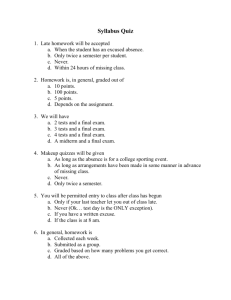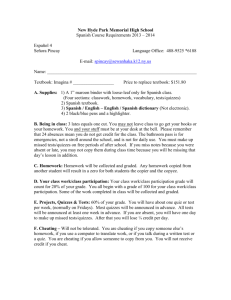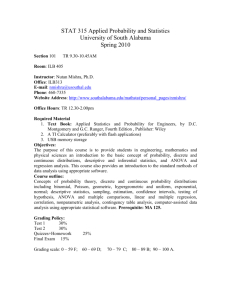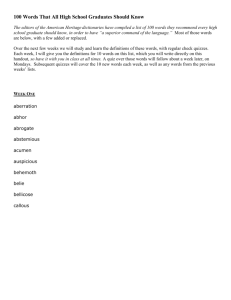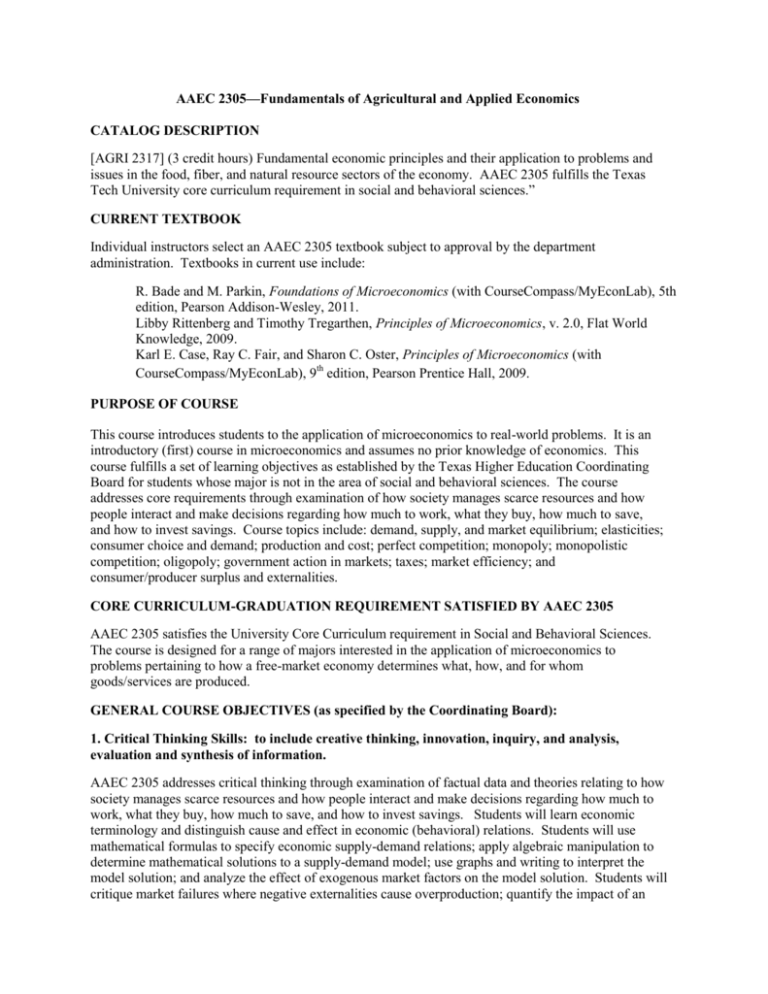
AAEC 2305—Fundamentals of Agricultural and Applied Economics
CATALOG DESCRIPTION
[AGRI 2317] (3 credit hours) Fundamental economic principles and their application to problems and
issues in the food, fiber, and natural resource sectors of the economy. AAEC 2305 fulfills the Texas
Tech University core curriculum requirement in social and behavioral sciences.”
CURRENT TEXTBOOK
Individual instructors select an AAEC 2305 textbook subject to approval by the department
administration. Textbooks in current use include:
R. Bade and M. Parkin, Foundations of Microeconomics (with CourseCompass/MyEconLab), 5th
edition, Pearson Addison-Wesley, 2011.
Libby Rittenberg and Timothy Tregarthen, Principles of Microeconomics, v. 2.0, Flat World
Knowledge, 2009.
Karl E. Case, Ray C. Fair, and Sharon C. Oster, Principles of Microeconomics (with
CourseCompass/MyEconLab), 9th edition, Pearson Prentice Hall, 2009.
PURPOSE OF COURSE
This course introduces students to the application of microeconomics to real-world problems. It is an
introductory (first) course in microeconomics and assumes no prior knowledge of economics. This
course fulfills a set of learning objectives as established by the Texas Higher Education Coordinating
Board for students whose major is not in the area of social and behavioral sciences. The course
addresses core requirements through examination of how society manages scarce resources and how
people interact and make decisions regarding how much to work, what they buy, how much to save,
and how to invest savings. Course topics include: demand, supply, and market equilibrium; elasticities;
consumer choice and demand; production and cost; perfect competition; monopoly; monopolistic
competition; oligopoly; government action in markets; taxes; market efficiency; and
consumer/producer surplus and externalities.
CORE CURRICULUM-GRADUATION REQUIREMENT SATISFIED BY AAEC 2305
AAEC 2305 satisfies the University Core Curriculum requirement in Social and Behavioral Sciences.
The course is designed for a range of majors interested in the application of microeconomics to
problems pertaining to how a free-market economy determines what, how, and for whom
goods/services are produced.
GENERAL COURSE OBJECTIVES (as specified by the Coordinating Board):
1. Critical Thinking Skills: to include creative thinking, innovation, inquiry, and analysis,
evaluation and synthesis of information.
AAEC 2305 addresses critical thinking through examination of factual data and theories relating to how
society manages scarce resources and how people interact and make decisions regarding how much to
work, what they buy, how much to save, and how to invest savings. Students will learn economic
terminology and distinguish cause and effect in economic (behavioral) relations. Students will use
mathematical formulas to specify economic supply-demand relations; apply algebraic manipulation to
determine mathematical solutions to a supply-demand model; use graphs and writing to interpret the
model solution; and analyze the effect of exogenous market factors on the model solution. Students will
critique market failures where negative externalities cause overproduction; quantify the impact of an
externality on society; and identify, discuss, explain (in writing), and compare policy actions targeting
more efficient outcomes. Students will evaluate alternative perceptions of “fairness” in regard to
allocation of scarce resources as they evaluate various social welfare functions, and will identify and
compare economic consequences of alternative government policies on resource allocation. Critical
thinking is assessed when students are asked to provide written and verbal answers to economic questions
that require analysis, synthesis, and evaluation of information from economic data, theory, and models of
human economic behavior.
Assessment Strategies: Students will be assessed on critical thinking skills through tests/exam, graded
and non-graded quizzes and assigned web-based problem sets, class discussion, polling the class, and retests of deficient areas. Here and for all other learning objectives we will be requiring that benchmarks be
established and that specific questions and other assessments be identified. That is, it is not sufficient to
say “students will be assessed through tests. Selected examination questions must be identified that test
specifically for critical thinking in the context of the course content.
2. Communication Skills: to include effective development, interpretation and expression of ideas
through written, oral and visual communication.
Course exams and quizzes include short and long answer questions where students are required to use
written communication. Graphs and diagrams are an important means to convey economic relationships
and provide the basis to explain economic theories. Students will be provided numerical data and asked
to construct tables and diagrams and provide a written interpretation of the data. Students will engage in
oral communication through class discussion of lecture material and graded and non-graded tests, quizzes,
and web-based problem sets.
Assessment strategies: Specific problems will be included in homework problem sets, quizzes,
tests/exam to assess communication skills.
3. Empirical and Quantitative Skills: to include the manipulation and analysis of numerical data or
observable facts resulting in informed conclusions.
Economic science has deep roots in the use of mathematical and graphical representation of economic
theories of human behavior. Students will use mathematical formulas to represent economic relations and
will use algebraic solution techniques to determine an equilibrium solution to an economic model. An
empirical side of economic science exists where numerical data are assembled and used to test economic
theories. Students will be presented with numerical data in tables and graphs and asked to evaluate,
discuss, and interpret the information using economic theories (and appropriate economic terms) so
informed conclusions are possible.
Assessment strategies: Empirical and quantitative skills will be assessed through tests/exam, web-based
application activities, graded and non-graded quizzes, web-based problem sets, class discussion, and
polling the class.
4. Social Responsibility: to include intercultural competence, knowledge of civic responsibility, and
the ability to engage effectively in regional, national, and global communities.
The difference between economically efficient outcomes and “fair” outcomes is emphasized to students in
text material and class lectures. As discussion of economic theory brings into sharp focus the problems of
public goods, free-riders, and external costs, students will calculate consumer and producer surplus and
use welfare analysis to identify and critique the impact on winners and losers of various institutional
policies. For example, students will analyze the motivation for and impact of negative externalities
(degradation of water quality) resulting from federal farm policies that induce inefficient over-production
of some commodity products by agricultural production firms. Students will identify and demonstrate
how establishment and enforcement of property rights and changes in government actions can achieve a
more efficient outcome that brings potential gains for everyone. As international trade of products is
ubiquitous in the world today, students will discuss and explain how policy actions in one community
have an effect on production, prices, and individual livelihoods in other communities in the modern
paradigm of a “flat world.” To this end, students will critique various world views prevailing in the
policy actions of a number of world trading partners as they compare the consequences of domestic
policies on other regional, national, and global communities.
Assessment strategies: Social responsibility will be assessed through tests/exam, web-based application
activities, graded and non-graded quizzes, web-based problem sets, class discussion, and polling the class.
COURSE-SPECIFIC LEARNING OBJECTIVES AND CORRESPONGING OUTCOMES.
1. Identify and critique alternative explanations for claims about social issues and human
behavior.
Given the complexity of human behavior and human interactions and the many types of institutional
motivations and potential government policies and regulations, a number of competing economic theories
of human behavior are offered to explain how individuals, groups, business firms, and government
interact in an economy to allocate scarce (limited) resources. Students will analyze and explain the basic
economic concepts behind these theories and will compare and critique alternative theories as
explanations of economic behavior. Students will create diagrams, apply mathematical formulas, and
discuss using written narrative to justify their understandings. A question arises in economics as to the
“fairness” of allocation of scarce resources. Students will compare alternate perceptions of “fairness” as
they evaluate various social welfare functions. Specifically, students will assess and compare economic
consequences of government policies developed to target “fairness of outcomes” with those targeting
“fairness of rules.”
Assessment of strategies: Web-based problem sets, class discussion, graded and non-graded quizzes,
and tests/exam will be used to assess student learning for this objective.
2. Demonstrate knowledge of the appropriate and ethical methods, technologies, and data that
social and behavioral scientists use to investigate the human condition.
Economists collect data and engage in positive (empirical) economics to validate economic theories and
explain human behavior in a marketplace. Students will be presented with numerical data in tables and
graphs and asked to discuss, compare, and critique alternative economic theories that explain how an
economy operates. In welfare analysis, economists combine empirical evidence with normative analysis
and provide information to policymakers to use in designing and implementing economic policies.
Students will identify and use tools of modern welfare analysis as they discuss and critique competing
policy actions. Students will outline, discuss, and explain the difference between economic efficiency
and fairness of allocation of resources and incomes. Students will be given problem sets that involve realworld economic issues and asked to use factual data, economic theory, and welfare analysis to analyze
and defend a particular normative viewpoint and/or economic policy that addresses human condition.
Assessment of strategies: Class discussion along with quizzes and tests/exam questions will be used to
assess students’ knowledge of the use of theory and data analysis to investigate human condition.
College-Level Competency: Students graduating from Texas Tech University should be able to
demonstrate the ability to assess critically claims about social issues, human behavior, and diversity
in human experiences. Students who complete AAEC 2305 will have knowledge of economic theories,
economic models, and the scientific method of testing economic models using real-world data. Through
problem sets, class discussion, and quiz and tests/exam questions, students will explain (using verbal,
diagrammatic, and mathematical representations) the basic concepts behind a simple economic model,
and will demonstrate mathematical/logical skills to solve and interpret the solution from the model. A
wide variety of examples will be selected to pique the interest of the diverse population of students who
enroll in AAEC 2305. Student learning outcomes will be assessed through graded homework problem
sets, quizzes, and embedded questions in tests/exam. A rubric rating approach using UNACCEPTABLE,
ADEQUATE, and SUPERIOR classifications will be used to assess achievement of learning outcomes.
The overall goal in this course is for the average of the class sample to achieve an ADEQUATE rubric
rating in each of the knowledge learning outcomes.
LEARNING ASSESSMENT:
Learning outcomes in this course will be assessed through tests/exam, graded and non-graded quizzes and
assigned web-based problem sets, class discussion, polling the class, and re-tests of deficient areas. These
assessments will specifically assess students’ learning with respect to the Core Social and Behavioral
Sciences objectives of critical thinking, communication skills, empirical/ quantitative skills, personal
responsibility, and social responsibility. In addition, students will be assessed on identifying and
critiquing alternative explanations of social issues and human behavior and on knowledge of the
appropriate ethical methods, technologies, and data used by social and behavioral scientists to investigate
the human condition. The following assessments represent a general department requirement:
Quizzes: Quizzes will be given throughout the semester. Questions on quizzes will cover the preparation
material for the week and recent class material. Individual quiz grades will be averaged in the calculation
of the Quizzes component of the Calculated Course Assessment.
Tests and Final Exam: Three tests and a final exam will be given. The tests will cover the material since
the beginning of the semester or the most recent test. The final exam will be comprehensive, covering all
the material assigned and covered since the beginning of the semester.
Problems: Problems will be assigned for completion either in-class or out-of-class. Several problem
assignments will be assigned through CourseCompass/MyEconLab and the grades used in the calculation
of the Problems component of the Calculated Course Assessment.
Calculated Course Assessment: The final grade for this course will be calculated based on the following
weightings:
Test 1
Test 2
Test 3
Final Exam
Quizzes
Problems
15%
15%
15%
15%
20%
20%
ABSENCE DUE TO RELIGIOUS OBSERVANCE:
A student who is absent from classes for the observance of a religious holy day will be allowed to take an
examination or complete an assignment scheduled for that day within a reasonable time after the absence
(University Catalog). Notification must be made in writing and delivered in person no later than the 15th
class day of the semester.
ABSENCE DUE TO OFFICIALLY APPROVED TRIPS:
A student who is absent due to an official trip should obtain a letter to that effect from the person
responsible for the student missing class. The student will not be penalized and is responsible for the
material missed (University Catalog).
ACCOMODATION OF STUDENTS WITH DISABILITIES:
Any student who, because of a disability, may require special arrangements in order to meet the course
requirements should contact the instructor as soon as possible to make any necessary arrangements.
Students should present appropriate verification from Student Disability Services during the instructor’s
office hours. Please note instructors are not allowed to provide classroom accommodations to a student
until appropriate verification from Student Disability Services has been provided. For additional
information, you may contact the Student Disability Services office in 335 West Hall or 806-742-2405.
ACADEMIC HONESTY STATEMENT:
The TTU “Code of Student Conduct”, which you should have received when you enrolled in the
university, contains a lengthy list of prohibited behaviors, among which is “Academic Dishonesty”.
Please note that cheating and plagiarism (a form of cheating) are included among the actions that are
subject to disciplinary action. Cheating will not be tolerated in this course. A student who is caught
cheating will receive a grade of 0 on the exam, paper, or exercise. Awarding of a grade of F for the course
is also a possible penalty. In addition, the incident of academic dishonesty will be reported to the Dean of
the appropriate academic college for such disciplinary action as they see fit to administer.
Plagiarism: “The appropriation or imitation of the language, ideas, and thoughts of another author, and
representation of them as one’s original work.” The Random House College Dictionary, revised edition.
New York: Random House, 1975, p. 1014. “1. The use, by paraphrase or direct quotation, of the
published or unpublished work of another person without full and clear acknowledgement; 2. the
unacknowledged use of materials prepared by another person or agency engaged in the selling of term
papers or other academic materials.” Student Affairs Handbook, Texas Tech University, Lubbock, Texas,
1998-99, p. 22. Plagiarism and cheating are not tolerated and will result in a grade of 0 on work that
contains plagiarized material. In addition, a grade of F may be awarded for the course. Any cases of
cheating will be reported to the Honors College and the responsible academic dean (i.e., Arts &Sciences,
Business Administration, Engineering, etc.)
CLASSROOM RULES AND BEHAVIOR:
Students are expected to show respect to classmates, instructors, and especially guest speakers. Consistent
with the stated assumptions and beliefs of Texas Tech University, the department has composed and the
department undergraduate association has endorsed the following set of rules for appropriate student
classroom behavior.
Do not talk during class meetings. Talking is disruptive to the instructor and to your fellow
classmates.
Do not arrive late to class and do not leave the classroom during class meetings. Exceptions may
occur for medical emergency, physiological urgency or situations where prior instructor approval has
been granted.
Do not use (including viewing of) communication devices (phones, etc) during class meetings. All
electronic devices should be silenced during class meetings.
Do not read/view other unassigned materials (newspapers, magazines, etc,) during class meetings.
Do not exhibit disruptive posture during class meetings. e.g. sleeping, slouching, laying, resting
feet/head on furniture, etc.
Do not use notebook computers during class meetings unless prior instructor approval has been
granted.
COURSE OUTLINE:
Week
1
2
3
4
5
6
7
8
9
10
11
Topic (based on Foundations of Microeconomics by Bade and Parkin)
Chapter(s)
Getting Started
US & Global Economies
The Economic Problem: Production Possibilities & Opportunity Cost
The Economic Problem: Growth & Specialization
Demand and Supply: Demand
Demand and Supply: Market Equilibrium
Elasticity: Price Elasticity of Demand
Elasticity: Price Elasticity of Supply
Elasticity: Cross Price and Income Elasticities of Demand
Efficiency: Allocation Methods & Definition
Efficiency: Consumer & Producer Surplus
Efficiency: Conditions and Fairness
Government Actions in Markets: Price Ceiling
Government Actions in Markets: Price Floor & Farm Price Supports
Taxes on Buyers and Sellers
Externalities: Pollution
Externalities: Common Resources
Public Goods & Choices: Classifying & the Free Rider Problem
Public Goods & Choices: Education
Consumer Choice and Demand: Consumption Possibilities (budget line)
Consumer Choice and Demand: Marginal Utility
Consumer Choice and Demand: Efficiency, Price, and Value
Production and Cost: Economic Cost and Profit
Production and Cost: Short Run Production
Ch. 1 + Appendix
Ch. 2
Ch. 3.1 & Ch. 3.2
Ch. 3.3 & Ch. 3.4
Ch. 4.1
Ch. 4.3
Ch. 5.1
Ch. 5.2
Ch. 5.3
Ch. 6.1
Ch. 6.2 & Ch. 6.3
Ch. 6.4 & Ch. 6.5
Ch. 7.1
Ch. 7.2 & Ch. 7.3
Ch. 8.1
Ch. 11.1
Ch. 11.2
Ch. 10.1 & 10.2
Ch. 10.3
Ch. 12.1
Ch. 12.2
Ch. 12.3
READ Ch. 13.1
READ Ch. 13.2
12
Production and Cost: Short Run Cost
Ch. 13.3
13
Production and Cost: Long Run Cost
Perfect Competition
Ch. 13.4
READ Ch. 14
14
Perfect Competition
Monopoly
READ Ch. 14
READ Ch. 15
15
Monopolistic Competition
Oligopoly
READ Ch. 16
READ Ch. 17

